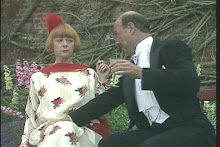Springfield, Illinois must boast the worst mishmash of architectural styles of any state capital in the nation -- I would say, of any community on the planet, but I could be wrong about that. Every visitor to the city comes, of course, to see this:
This is Abraham Lincoln's home, restored, but not with too heavy a hand, the National Park Service men told us. Eighty percent of the interior is original, as is sixty percent of the exterior. It sits in a neighborhood that looks reassuringly familiar -- spacious, calm, manicured and even up-to-date. The little four-block area might be a corner of any comfortable midwestern town even today, except for the gravel "streets" and the wooden "sidewalks." I use quotation marks because all of it except for Lincoln's house, right down to those streets and sidewalks, is reconstructed. Even if you weren't told so you would probably guess it. The beautiful houses have an eerie, perfect, plastic look, and if you venture inside those that have been rendered museums, you find the rooms are all painted a dull, clean, sensible museum-gray. Tap on the marble-look mantelpieces. Fake. They ring like metal.
Above, for instance, is a house painstakingly recreated to suggest one that belonged to a Lincoln neighbor. (His is behind you and across the street to your right when you stand here.) I couldn't resist snapping a photo of the view that neither Lincoln nor the neighbor ever saw: some modern municipal buildings, and the Hilton hotel towering over the city. This is what I mean by mishmash. Had I also troubled to photograph the new Abraham Lincoln Museum and its companion Library, both great tiered circles of shining wheat-blond stone and glass amid the gray concrete parking garages and the plain brown office piles and the circa 1890s brick and multicolored storefronts downtown, not far from the weathered Greek columns of the Old State Capitol, well -- you would have seen mishmash with a vengeance.
If only it all looked as turn-of-the-twentieth-century-dignified as this.
On the right of this photo, the Greek-columned Old State Capitol, again. Site of the famed "house divided" speech, 1858.
There was one more very interesting house in Lincoln's neighborhood, this time a real one, falling to pieces with age but more alive than all the others for all that. I wonder if this is what an architectural historian might call a piece of Victorian gingerbread.
I wonder, too, if the colors of pale salmon and slate blue were the height of chic at the time. When I look at it somehow I imagine the daughter of the family, a hundred or more years ago, dressing and primping excitedly for her first grown-up party. Fond father, town brahmin complete with watch chain, mutton chop whiskers, and monocle, looking on, etc. The house has a femininity about it, right down to the violets and grasses still struggling to grow in the yard, and the ivies trailing into the deep sunken brick-lined bowl which I suppose was once a fish pond, or the basin to Mother's precious fountain. In the photo below, you are standing with the house at your back, at the bottom of "Old Aristocracy Hill" -- the sign says so -- and looking up Eighth Street toward the Lincolns' place in the distance.
The salmon-and-blue affair is surely within a hair's breadth of being condemned and torn down; bright warning official stickers on the boarded windows are already almost too weathered for passersby to be able to read "Dangerous Structure" on them. This is what happened I feel sure, one by one, to the real houses near Lincoln's corner, and this is why all the reconstructed homes around his are such perfect but eerie ghosts. They all just weathered and crumbled. This house is for sale, but would cost a fortune to revive. It lies outside the sacred precincts which the National Park Service now owns and keeps frozen in 1860, so I imagine if it were not perfectly revived -- if you bought it and did what you liked with it -- if it were simply made safe, pretty, and livable, that would be all right.
In fact I almost wish all the others up the street had not been so perfectly revived themselves. Though the window back into time which they provide is interesting, I wish living families with children were still in these homes, even at the price of historically inaccurate doorknobs or windows glowing blue with television, rather than that Lincoln's part of the town should be the so pristine, still and dead. Our park service guides lamented to us that, before the government began buying up the four block area with preservation in mind, there had been not only real people's, non-1860 homes all around but also "a Piggly-Wiggly" (tacky grocery store chain) cheek by jowl with the Lincoln shrine. Well, what if there was? People need groceries, and Lincoln, ex-store clerk, was nothing if not sympathetic to the human comedy. By this lofty argument, however, I should not complain about the mishmash effect of Springfield's architecture taken altogether. People need parking garages, and hotels.
A final thought, prompted by the scenery on a warm spring day. Springfield gives the strange impression that it would never have remained the state capitol were it not for Abraham Lincoln's presence here. The seat of Illinois government, already four or five times removed from more rural locales before arriving here in the 1840s, would have naturally moved on again. The mishmash, the isolation and the ghostliness are un-capital-like. And then, the rolling up of sidewalks on Saturday night is another matter.



























